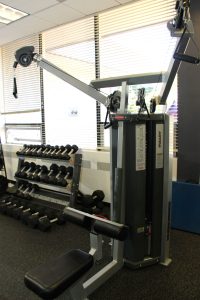Most personal trainers love free motion exercises over fixed plane machine exercises because they allow a lifter to move the resistance freely through space, which offers an advantage. Moving a weight freely through space requires stability and control. This action helps to place a demand on the stabilizer and assistive muscles along with the prime mover being targeted. Machines generally travel in a fixed plane and rely much less on the muscles used to stabilize the joint.
Is one better than the other? If not, how can we utilize them each to their greatest potential?
What is Fixed Plane Training?
Fixed plane is an exercise where the resistance is moved along a fixed plain by the body lever performing the work. Generally, a fixed plane exercise is performed on a machine.
Consider the advantages of a fixed plane exercise. Since the line of force is linear you can concentrate on applying the maximum amount of force in a single direction. This will allow you to use a greater amount of resistance. There is always a certain amount of wasted effort in moving a weight in a given direction if the weight is free to move in multiple planes.
By not having to control the direction that the resistance travels you can put one hundred percent of your force into moving as much weight as you can handle. That translates into a greater load on the target muscles. Another advantage to fixed motion exercises is that a person with a tendonitis or joint problems may be able to perform them without the pain they may experience when doing a free motion exercise.
Often times the small stabilizers are what is inflamed and not the prime mover. The downside is that the stabilizers will not get strengthened unless they are being used.
What is Free Motion Training?
Free motion is an exercise where the resistance is free to move in multiple directions and must be guided to move in a given plain by both the prime mover muscles and stabilizer muscles that are helping to control the motion. A free motion exercise can be performed using any form of resistance that is not fixed to move in a linear fashion. Free motion exercises can be performed with cables, free weights, body weight, bands, and tubes or suspension trainers.
The method of providing resistance is of less importance than the freedom of motion that creates an unstable motion at the body lever. Because free weight exercises call upon other muscles to stabilize the body lever as it moves the resistance along the desired plane they are more functional than moving a fixed form of resistance in a straight or otherwise fixed plane of motion.

Fusing Fixed Plane and Free Motion Training
The good news is that you don’t have to choose between fixed plane or free motion; you can train both in superset fashion and get the best of both worlds.
The best way to superset a fixed plane and free motion exercise is to find a pair of exercises that both work the same muscle group.
The first exercise would be a fixed plane exercise such as a leg press or chest press. The reason I like to start with the fixed plane exercise is that it is the exercise that allows you to use the most resistance. Once the prime mover has been fatigued the stabilizers can be worked with much less resistance.
Because the load on the stabilizers is less you have a much lower risk of exacerbating an old injury. The trainee can focus on applying force more gradually whereas a heavy resistance requires more explosiveness to generate enough force to move the resistance through space.
Some exercises that pair well together are machine chest press and band flys, leg press and reverse lunges just to name a few.
Try alternating fixed plane and free motion exercises in your training program for clients. Finding the right order of exercises for each client helps them hit that sweet spot they’re looking for when working out.
[info type=”facebook”]Do you use more free motion or fixed plane exercises with clients? Come talk with your fellow trainers on the Community Page. If you’re not NFPT Certified, come chat with NFPT here – we’d love to meet you![/info]
John Rutnik is a NFPT Certified Personal Trainer. He holds an AAS in Electrical Technology and has been a certified personal trainer since 2008. John has been involved in physical fitness and weight training since the late 70’s and is an avid outdoors man. He became a personal trainer after rehabilitating himself from a spinal injury he sustained in a car accident and losing 70 pounds. John later obtained ISSA Certifications as both a Fitness Trainer and Specialist in Sports Nutrition and became Lead Fitness Trainer at Anytime Fitness in Schenectady NY. His training philosophy is “no man left behind,” everyone deserves a chance to succeed.

